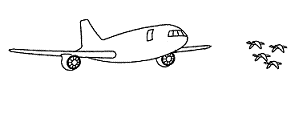Bird Strike Committee Proceedings
Date of this Version
8-8-2000
Abstract
Laser technology has recently been demonstrated as a potentially effective avian repellent; however, controlled studies have not been reported. We conducted 2-choice cage tests to quantify the effectiveness of low-power (10−60-mW) 633−650-nm lasers in preventing Brown-headed Cowbirds (Molothrus ater), European Starlings (Sturnus vulgaris), and Rock Doves (Columbia livia) from perching and Canada Geese (Branta canadensis) and Mallards (Anas platyrhynchos) from use of grass plots. In 3 experiments with stationary and moving laser beams “defending” a randomly selected perch, brown-headed cowbirds were not repelled, nor did they exhibit behaviors indicating perception of the beam. Similarly, a moving beam did not repel European Starlings from treated perches. Rock Doves exhibited avoidance behavior only during the first 5 minutes of 6, 80-minute sessions involving a moving beam. Notably, 6 groups of geese (4 birds/group) exhibited marked repellency to a moving beam in 20-minute sessions (n = 23), with a mean 96% of birds repelled from laser-treated plots. Six groups of Mallards (6 birds/group) were also repelled (X = 53%) from treated plots during 2, 20-minute sessions, but habituated to the beam after approximately 20 minutes. Roosting Canada geese, American Crows (Corvus brachyrhynchos), several members of the Anatidae, and various wading bird species were dispersed successfully (from up to 457 m) during field trials. We contend that lasers may prove useful as avian repellents, and may be used to increase avian awareness of aircraft. However, further controlled studies are needed to evaluate species-specific responses relative laser power, beam type, wavelength, and light conditions.

